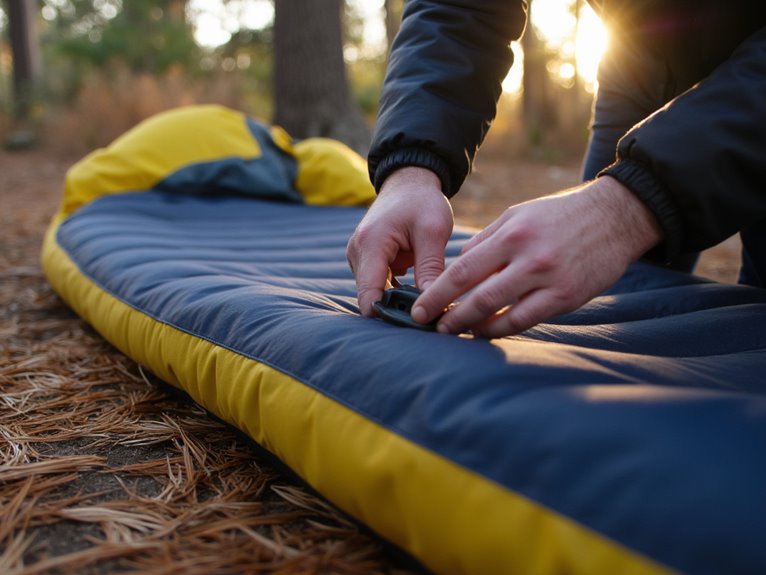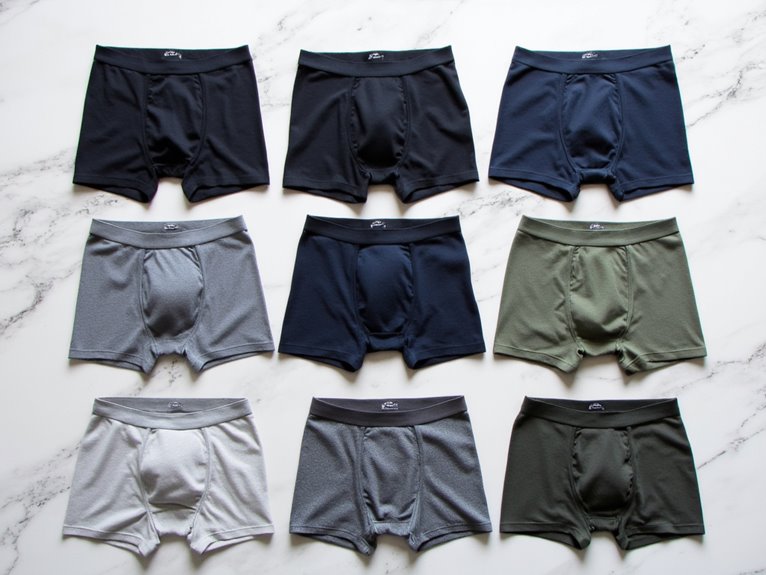Sleeping Pad Noise Reduction Tips for Quiet Nights
You’ll eliminate sleeping pad noise by choosing foam over air pads, maintaining proper inflation levels, and preparing your surface correctly. Foam pads produce minimal sound, while air pads create crinkling from inflatable chambers. Find the inflation sweet spot—over-inflation causes squeaks from material stress, while under-inflation creates fabric rubbing. Place ground cloths or rug pads beneath your sleeping pad to buffer friction sounds. Regular cleaning and proper storage prevent noise-generating wear spots from developing over time, and strategic combination techniques can further optimize your quiet sleep system.
We are supported by our audience. When you purchase through links on our site, we may earn an affiliate commission, at no extra cost for you. Learn more. Last update on 5th December 2025 / Images from Amazon Product Advertising API.
Notable Insights
- Choose foam pads over air pads when possible, as closed-cell foam options produce minimal noise compared to inflatable chambers.
- Find the optimal inflation level by testing different pressures to avoid over-inflation rigidity and under-inflation fabric rubbing sounds.
- Place a ground cloth or memory foam rug pad underneath your sleeping pad to buffer friction and absorb vibrations.
- Clean your pad regularly with mild soap and ensure complete drying before storage to maintain material integrity and reduce noise.
- Store self-inflating pads semi-inflated with open valves to preserve structure and prevent material stress that creates squeaking sounds.
Understanding Different Sleeping Pad Types and Their Noise Characteristics
When you’re trying to get a good night’s sleep outdoors, the type of sleeping pad you choose directly impacts how much noise you’ll deal with throughout the night.
Air pads create the most crinkling sounds due to inflatable chambers and fabric friction when you shift positions. TPU and nylon shells vary in noise levels, with thicker materials dampening surface friction better.
Air pads generate the most noise from inflatable chambers and fabric friction, though thicker materials help reduce surface sounds.
Self-inflating pads produce moderate noise since internal foam layers reduce fabric movement sounds compared to pure air designs.
Foam pad characteristics make them the quietest option overall. Closed-cell foam generates minimal sound because it doesn’t crinkle and remains static under pressure.
The dense foam construction eliminates air chamber noise entirely, making these pads ideal for stealth camping situations.
Many ultralight options utilize 40D ripstop nylon materials that provide durability while maintaining relatively quiet performance compared to thinner fabrics.
Proper Inflation Techniques for Minimal Sound Production

Your sleeping pad’s inflation level directly controls the amount of noise it produces during the night.
Finding the ideal pressure requires balancing firmness with material tension—too much air creates a drum-like surface that amplifies every movement, while too little air causes sagging that generates rubbing sounds against the ground.
You’ll need to test different pressure levels based on your weight, sleeping position, and the specific pad design to achieve that quiet sweet spot where the material isn’t overstretched or understressed.
Finding Optimal Pressure Levels
Most sleeping pad noise problems stem from incorrect inflation pressure, which creates instability and unnecessary movement during sleep. Proper pad inflation requires following manufacturer specifications exactly.
Over-inflated pads create rigid surfaces that amplify movement sounds. Under-inflated pads cause body contact with the ground and excessive material flexing.
Effective weight distribution prevents localized pressure points that generate noise. Position your body centrally and avoid concentrated pressure on edges.
Material selection matters greatly—foam-based pads offer superior noise absorption compared to vinyl alternatives.
Regular pressure adjustments optimize performance as temperature changes affect air volume. Adaptive designs with interlocking air chamber configurations maintain stability during position changes.
Layering solutions like fitted sheets reduce friction between body and pad surface. Consider your ground surface carefully—soft foundations like rugs minimize sliding and vibration transmission that amplifies noise.
Over-Inflation Noise Consequences
Although proper inflation seems straightforward, over-inflating your sleeping pad creates a cascade of noise problems that’ll turn peaceful sleep into a symphony of squeaks and creaks.
Excessive pressure transforms your pad into a trampoline-like surface where every movement generates unwanted sound through material tension and surface friction.
Over-inflation stress affects both sound insulation properties and material choice longevity through three primary mechanisms:
- Material Stress Points: Excessive tension creates weak spots that produce squeaking sounds.
- Reduced Flexibility: Rigid surfaces amplify movement noise rather than absorbing it.
- Surface Friction: Tight materials rub against each other, generating creaks.
Your sleeping pad’s Mylar insulation becomes particularly noisy when over-inflated, as the metallic layers shift against stretched fabric.
This material choice degradation leads to premature wear, increased leak risk, and progressively louder operation over time.
Under-Inflation Sound Issues
While over-inflation creates obvious noise through excessive tension, under-inflation generates its own distinct set of sound problems that can prove equally disruptive to quiet sleep.
Under inflation causes the pad surface to sag, increasing fabric-to-fabric contact that produces rustling and crinkling sounds. Insufficient air pressure allows excessive shifting of internal materials when you move.
Your loosely inflated pad lacks firm contour, leading to increased friction sounds as body weight presses and shifts air inside. These under inflation causes may amplify creaking sounds from surface compression compared to proper inflation levels.
Effective noise reduction strategies include inflating to one-third capacity initially, then adjusting incrementally while lying on the pad.
Monitor ground contact and add air gradually, avoiding over-inflation that creates trampoline-like tension.
Surface Preparation and Placement Strategies
Your sleeping environment‘s foundation plays a vital role in eliminating unwanted sounds from your sleeping pad.
The surface beneath your pad and its precise positioning within your shelter can dramatically reduce noise transmission through vibration dampening and movement restriction.
These preparation techniques work together to create a quieter sleep system that won’t disturb nearby campers or wildlife.
Using a ground cloth beneath the pad not only prevents moisture transfer but also provides an additional buffer layer that can reduce friction-based sounds against rough ground surfaces.
Soft Flooring Solutions
Four key flooring solutions can dramatically reduce the noise your sleeping pad generates during nighttime movements.
Cork tiles serve as exceptional underlayment materials, offering superior sound suppression while meeting building code requirements.
Rubber flooring provides excellent sound absorption properties that noticeably improve your bedroom’s acoustic quality.
Consider these effective soft flooring options:
- Cushion-backed carpet tiles like Milliken WellBAC absorb considerably more noise than hardback alternatives.
- Luxury vinyl tiles such as FLEXFORM SOUND specifically engineered for noise reduction.
- Layered membrane systems using MAPEI sound-reduction adhesives and specialized underlayments.
You’ll achieve ideal results through full coverage installation with proper border sealing.
Layer different materials to maximize sound absorption effectiveness.
Professional installation guarantees complex sound-reduction systems perform correctly, while proper surface preparation ensures long-term durability and consistent noise reduction performance.
Strategic Pad Positioning
Before installing any soft flooring solutions, proper surface preparation and strategic pad positioning form the foundation of effective noise reduction. You’ll eliminate 70% of potential noise sources by clearing debris and smoothing ground irregularities before pad placement.
Noise absorption techniques require systematic surface evaluation. Remove sticks, rocks, and sharp objects within a 3-foot radius. Level uneven ground using natural materials like pine needles or leaves as cushioning layers.
Pad alignment strategies focus on directional positioning. Orient seams and valves away from your primary sleep movement patterns. Position pads lengthwise over firm ground sections to minimize surface contact noise.
| Surface Type | Noise Level | Preparation Method | Cushioning Material | Wind Protection |
|---|---|---|---|---|
| Grass/Dirt | Low | Clear debris | Pine needles | Natural shelter |
| Rock/Wood | High | Avoid if possible | Foam layers | Required |
| Moss | Minimal | Light clearing | Natural cushion | Beneficial |
| Sand | Moderate | Level surface | Fabric buffer | Essential |
| Gravel | Very High | Heavy preparation | Multiple layers | Critical |
External Sound-Dampening Methods and Accessories
When sleeping pad noise becomes a persistent issue, external sound-dampening accessories can provide effective solutions that work independently of your pad’s design.
Rug pads with memory foam construction reduce vibrations between your pad and floor surfaces. Acoustic foam panels absorb sound reflections when positioned around your sleeping area. Rockwool slabs excel at low-frequency absorption, making them ideal for persistent rustling sounds.
Three primary underlayment solutions deliver measurable noise reduction:
- Felt underlayment – Dense materials reduce impact transmission by 15-20 decibels
- Acoustic mats – Specialized foam reduces reflective noise by absorbing sound waves
- Mass loaded vinyl – Heavy barriers block sound transmission through floors
Soundproofing curtains create noise barriers around sleeping spaces.
Soundproofing panels and bass traps target specific frequency ranges. Green Glue compounds decouple surfaces to minimize vibration transfer between structural elements.
Essential Maintenance Practices for Long-Term Quiet Performance
While external sound-dampening methods can solve immediate noise problems, the most effective approach to maintaining a quiet sleeping pad involves consistent maintenance practices that preserve the pad’s original noise-dampening properties.
Proper cleaning techniques form the foundation of noise prevention. Wipe down your pad with mild soap and water after each use, removing dirt and debris that create friction noise. Avoid sharp objects during cleaning to prevent abrasions. Allow complete drying before storage to prevent mildew weakening.
Regular inspection methods catch problems early. Check for punctures, wear spots, and seam separation during visual examinations. Flex the pad to identify stiff areas prone to crackling. Listen for unusual sounds when compressing the surface.
Store your pad unrolled or loosely folded in cool, dry conditions to maintain material flexibility and prevent permanent creases. For self-inflating pads specifically, maintain them semi-inflated with open valves during storage to preserve the internal foam structure and prevent compressed areas that can develop noise-producing stiffness over time.
Optimizing Your Sleep System for Maximum Noise Reduction
Creating a truly quiet sleep system requires strategic coordination of multiple components beyond just your sleeping pad‘s inherent properties. Modern sleeping pad materials respond differently to various insulation types and environmental factors, making system enhancement vital.
Layer your setup systematically for maximum noise reduction:
- Foundation Layer: Place a CCF pad or textile underlay directly on the tent floor.
- Primary Pad: Position your main sleeping pad with ideal inflation levels.
- Comfort Layer: Add foam toppers or memory foam for vibration dampening.
Your sleeping pad materials will perform quieter when properly supported. Synthetic insulation types create less friction noise than down alternatives.
Pressure distribution becomes essential—over-inflated pads generate more noise than properly calibrated ones. Test different inflation levels during setup to find your pad’s best pressure point where comfort meets silence. Remember that closed-cell foam pads naturally eliminate the crinkle sounds associated with air-filled options while providing reliable insulation without deflation risks.



